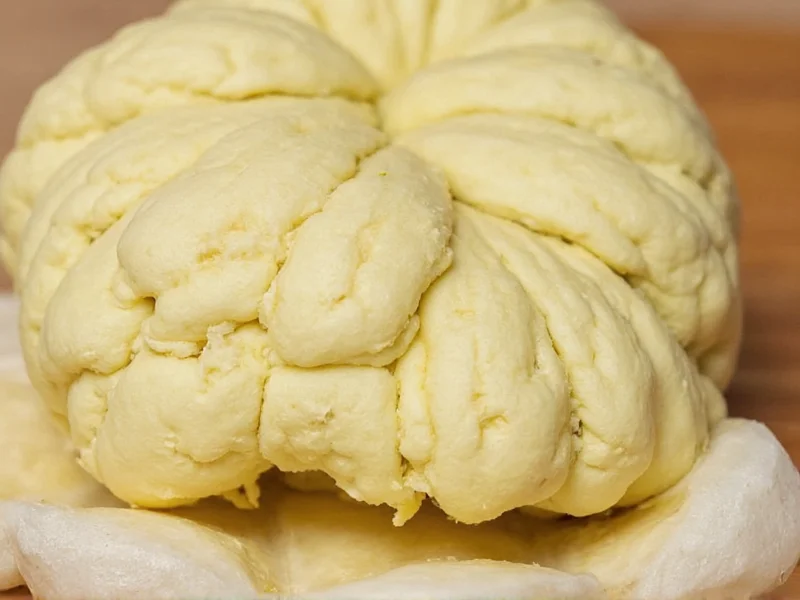Understanding what horseradish is made of requires distinguishing between the raw plant and the prepared condiment most people consume. The horseradish plant (Armoracia rusticana) is a hardy perennial vegetable grown for its large, white, tapered root. This root alone constitutes pure horseradish in its most basic form, but it transforms dramatically when processed.
The Science Behind Horseradish's Heat
Raw horseradish root contains separate compounds called sinigrin (a glucosinolate) and myrosinase (an enzyme). These remain inert while the root is intact. When you grate or crush the root, these compounds mix and react to produce allyl isothiocyanate—the volatile compound responsible for horseradish's intense aroma and sinus-clearing heat.
This chemical reaction explains why freshly prepared horseradish has maximum potency. The heat peaks within minutes of grating and gradually diminishes as the volatile compounds evaporate. This is also why commercial producers add vinegar early in the preparation process—to halt the enzymatic reaction at the desired heat level.
Traditional vs. Commercial Preparation Methods
Homemade horseradish follows a simple process:
- Peel fresh horseradish root
- Grate or finely chop the root
- Immediately mix with vinegar (typically 3-6% acidity)
- Add salt to taste
- Allow to mellow for 1-2 days before consumption
Commercial horseradish products often include additional ingredients to enhance shelf stability and flavor consistency:
| Ingredient | Purpose | Typical Percentage |
|---|---|---|
| Grated horseradish root | Primary flavor component | 60-80% |
| Vinegar (5-7% acidity) | Stabilizes heat level, prevents browning | 15-30% |
| Salt | Enhances flavor, acts as preservative | 1-3% |
| Lemon juice or ascorbic acid | Prevents oxidation, maintains color | 0.5-2% |
| Cream (in creamy varieties) | Mellows heat, creates smooth texture | 5-15% |
Why It's Called Horseradish (Despite No Horses)
The "horse" in horseradish doesn't refer to the animal but rather comes from the Old English word "hors," meaning coarse or rough. Historical records show the term "horseradish" appeared in English botanical texts as early as 1548. The "radish" portion connects it to the Raphanus genus, though horseradish actually belongs to a different genus (Armoracia).
Nutritional Composition
Horseradish in its purest form (just root and vinegar) offers minimal calories but contains several beneficial compounds:
- Vitamin C: A single tablespoon provides about 7% of daily value
- Potassium: Supports healthy blood pressure
- Calcium: Important for bone health
- Glucosinolates: Plant compounds with potential anti-cancer properties
- Isothiocyanates: The compounds responsible for heat may have antimicrobial benefits
Commercial creamy varieties contain additional calories from dairy ingredients, while sweetened versions may include sugar or corn syrup.
Storage and Shelf Life Considerations
Understanding what horseradish is made of explains its relatively short shelf life. Freshly grated horseradish begins losing potency within hours. Commercial products maintain stability through:
- Vinegar content (typically 5-7% acidity)
- Air-tight packaging that limits oxygen exposure
- Refrigeration requirements (always store horseradish in the refrigerator)
- Acidulants like citric acid to maintain pH
Once opened, most horseradish products remain at peak quality for 4-8 weeks when properly refrigerated. Signs of deterioration include darkening color, separation of ingredients, and diminished heat level.
Culinary Applications and Pairings
The distinctive composition of horseradish makes it exceptionally versatile in cooking. Its sharp heat complements:
- Beef dishes (particularly roast beef and steak)
- Seafood sauces and cocktail sauce
- Root vegetable purees
- Vinaigrettes and creamy dressings
- Egg dishes like deviled eggs
Chefs appreciate how horseradish's heat differs from chili peppers—it stimulates the nasal passages more than the tongue, creating a different sensory experience. This characteristic makes it particularly effective in cutting through rich, fatty foods.
Common Misconceptions About Horseradish
Several myths persist about what horseradish is made of:
- Myth: Horseradish contains actual horse products
Fact: The name refers to the coarse nature of the root, not animal content - Myth: Wasabi is made from horseradish
Fact: Most "wasabi" outside Japan is horseradish dyed green, but real wasabi comes from Wasabia japonica - Myth: Horseradish continues to get hotter over time
Fact: Heat peaks quickly then diminishes as volatile compounds evaporate
FAQ
What is the main ingredient in horseradish?
The main ingredient in horseradish is the grated root of the Armoracia rusticana plant. Commercial preparations typically combine this with vinegar (to stabilize the heat), salt, and sometimes cream or lemon juice. Pure horseradish contains no animal products despite its name.
Does horseradish contain any dairy products?
Plain horseradish does not contain dairy—it's simply grated root preserved with vinegar. However, "creamy horseradish" varieties do contain dairy ingredients like sour cream or mayonnaise. Always check the ingredients list if you have dietary restrictions, as formulations vary by brand.
Why does horseradish lose its heat over time?
Horseradish loses heat because the volatile allyl isothiocyanate compounds responsible for its pungency gradually evaporate. When the root is grated, enzymes create these compounds, but they're unstable. Vinegar halts the reaction at a certain point, but the compounds still dissipate over time, especially when exposed to air. This is why freshly prepared horseradish has the strongest heat.
Is horseradish vegan?
Plain horseradish (just root, vinegar, and salt) is vegan. However, creamy horseradish varieties often contain dairy products like sour cream or mayonnaise. Some commercial brands might use non-vegan processing agents. Always check the ingredients list if following a strict vegan diet, as formulations vary between manufacturers.
How is horseradish different from wasabi?
While often substituted for one another, horseradish and wasabi come from different plants. Horseradish (Armoracia rusticana) has a sharper, more intense heat that affects the nasal passages. Real wasabi (Wasabia japonica) has a more complex flavor with a gentler heat that dissipates quickly. Most "wasabi" served outside Japan is actually horseradish dyed green with food coloring and sometimes flavored with mustard.











 浙公网安备
33010002000092号
浙公网安备
33010002000092号 浙B2-20120091-4
浙B2-20120091-4